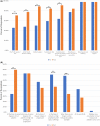Regional adaptation of the education in palliative and end-of-life Care Pediatrics (EPEC-Pediatrics) curriculum in Eurasia
- PMID: 36073348
- PMCID: PMC9939085
- DOI: 10.1002/cam4.5213
Regional adaptation of the education in palliative and end-of-life Care Pediatrics (EPEC-Pediatrics) curriculum in Eurasia
Abstract
Background: Pediatric palliative care (PPC) is a priority to improve pediatric hematology oncology (PHO) care in Eurasia. However, there are limited regional opportunities for PPC education. We describe the adaptation and implementation of a bilingual end-user Education in Palliative and End-of-Life Care (EPEC)-Pediatrics course for PHO clinicians in Eurasia.
Methods: Due to COVID-19, this course was delivered virtually, consisting of prerecorded, asynchronous lectures, and a bilingual workshop with interactive lectures and small group sessions. A pre-postcourse design was used to evaluate the knowledge acquisition of the participants including their knowledge alignment with World Health Organization (WHO) guidance, ideal timing of palliative care, and comfort in providing palliative care to their patients. Questions were mostly quantitative with multiple choice or Likert scale options, supplemented by free-text responses.
Results: A total of 44 (76%) participants from 14 countries completed all components of the course including pre- and postcourse assessments. Participant alignment with WHO guidance improved from 75% in the pre- to 90% in the postcourse assessments (p < 0.001). After participation, 93% felt more confident controlling the suffering of children at the end of life, 91% felt more confident in prescribing opioids and managing pain, and 98% better understood how to hold difficult conversations with patients and families. Most participants (98%) stated that they will change their clinical practice based on the skills and knowledge gained in this course.
Conclusions: We present a successful regional adaptation of the EPEC-Pediatrics curriculum, including novel delivery of course content via a virtual bilingual format. This course resulted in significant improvement in participant attitudes and knowledge of PPC along with an understanding of the ideal timing of palliative care consultation and comfort in providing PPC to children with cancer. We plan to incorporate participant feedback to improve the course and repeat it annually to improve access to high-quality palliative care education for PHO clinicians in Eurasia.
Keywords: Eurasia; education; pediatric oncology; pediatric palliative care.
© 2022 The Authors. Cancer Medicine published by John Wiley & Sons Ltd.
Conflict of interest statement
The authors declared that they have no conflict of interest.
Figures


References
-
- WHO Definition of Palliative Care/WHO Definition of Palliative Care for Children. World Health Organization; 2002. http://www.who.int/cancer/palliative/definition/en/. Accessed 21 July 2021.
-
- World Health Organization . Integrating Palliative Care and Symptom Relief into Paediatrics: A WHO Guide for Health Care Planners. World Health Organization; 2018.
-
- Resolution WHA67.19 . Strengthening of Palliative Care as a Component of Comprehensive Care Throughout the Life Course. In Proceedings of the Sixty‐seventh World Health Assembly, Geneva, Switzerland, 19–24 May 2014. World Health Organization; 2014. http://apps.who.int/gb/ebwha/pdf_files/WHA67/A67_R19‐en.pdf Accessed 21 July 2021.
-
- Knapp C, Woodworth L, Wright M, et al. Paediatric palliative care provision around the world: A systematic review. Pediatr Blood Cancer. 2011;57:361‐368. - PubMed
-
- Connor SR, Sepulveda Bermedo MC. Global Atlas of Palliative Care at the end of Life. 2nd ed. Worldwide Palliative Care Alliance; 2020.
Publication types
MeSH terms
LinkOut - more resources
Full Text Sources
Medical

